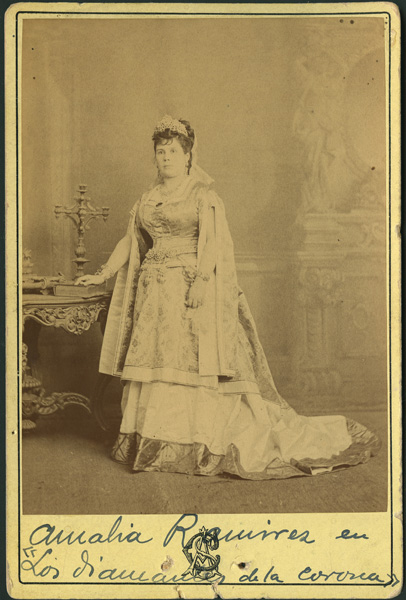|
Los Diamantes De La Corona
''Los diamantes de la corona'' is a zarzuela in three acts by the composer Francisco Asenjo Barbieri with a libretto by Francisco Camprodón.Salter, Lionel. Barbieri, Francisco Asenjo. In: ''The New Grove Dictionary of Opera.'' Macmillan, London and New York, 1997. The opera is taken from the original French libretto by Eugène Scribe Augustin Eugène Scribe (; 24 December 179120 February 1861) was a French dramatist and librettist. He is known for writing "well-made plays" ("pièces bien faites"), a mainstay of popular theatre for over 100 years, and as the librettist of man ... and Jules-Henri Vernoy de Saint-Georges which was set to music by Daniel Auber in 1841. Barbieri's work was first performed at the Teatro del Circo in Madrid on 15 September 1854. Auber's work retained popularity at the Opéra-Comique from its première there in 1841 (receiving 180 performances in its first eight seasons), with over 370 performances up to the fire of 1887.Soubies A, Malherbe C. ''Hi ... [...More Info...] [...Related Items...] OR: [Wikipedia] [Google] [Baidu] |
Zarzuela
() is a Spanish lyric-dramatic genre that alternates between spoken and sung scenes, the latter incorporating operatic and popular songs, as well as dance. The etymology of the name is uncertain, but some propose it may derive from the name of a royal hunting lodge, the Palace of Zarzuela, near Madrid, where that type of entertainment was allegedly first presented to the court. The palace in turn was named after the brambles () that grew there. There are two main forms of ''zarzuela'': Baroque ''zarzuela'' (c. 1630–1750), the earliest style, and Romantic ''zarzuela'' (c. 1850–1950). Romantic zarzuelas can be further divided into two main subgenres, ''género grande'' and ''género chico'', although other sub-divisions exist. ''Zarzuela'' spread to the Spanish dominions, and many Spanish-speaking countries – notably Cuba – developed their own traditions. ''Zarzuela'' is also a strong tradition in the Philippines, where it is also referred to in certain ... [...More Info...] [...Related Items...] OR: [Wikipedia] [Google] [Baidu] |
Ataúlfo Argenta
Ataúlfo Exuperio Martín de Argenta Maza (19 November 1913 – 20 January 1958) was a Spanish conductor and pianist. Biography Argenta was born in Castro Urdiales, Cantabria, one of the two children, and the only son, of the local station master and a worker with the railways, Juan Martín de Argenta, and Laura Maza. Argenta showed a talent for singing as a youth, and sang in the church of Santa María. He later studied violin and piano. His teachers included Vicente Aznar and Blanco Justo. He went to school at Doctrina Cristiana, playing locally in the cinema and at Círculo Católico concerts. He suffered from tuberculosis as a youth. In 1927, Argenta's family moved to Madrid, where his father worked in the head-office of the State Railways, and where Argenta began studies at the Real Conservatorio Superior de Música (Madrid Conservatory). His teachers included Fernández Alberdi and Conrado de Campo. He won a ''Premio Extraordinario'' for piano in 1930. His fellow ... [...More Info...] [...Related Items...] OR: [Wikipedia] [Google] [Baidu] |
Zarzuelas
() is a Spanish lyric-dramatic genre that alternates between spoken and sung scenes, the latter incorporating operatic and popular songs, as well as dance. The etymology of the name is uncertain, but some propose it may derive from the name of a royal hunting lodge, the Palace of Zarzuela, near Madrid, where that type of entertainment was allegedly first presented to the court. The palace in turn was named after the brambles () that grew there. There are two main forms of ''zarzuela'': Baroque ''zarzuela'' (c. 1630–1750), the earliest style, and Romantic ''zarzuela'' (c. 1850–1950). Romantic zarzuelas can be further divided into two main subgenres, ''género grande'' and ''género chico'', although other sub-divisions exist. ''Zarzuela'' spread to the Spanish dominions, and many Spanish-speaking countries – notably Cuba – developed their own traditions. ''Zarzuela'' is also a strong tradition in the Philippines, where it is also referred to in certain ... [...More Info...] [...Related Items...] OR: [Wikipedia] [Google] [Baidu] |
1854 Operas
Events January–March * January 4 – The McDonald Islands are discovered by Captain William McDonald aboard the ''Samarang''. * January 6 – The fictional detective Sherlock Holmes is perhaps born. * January 9 – The Teutonia Männerchor in Pittsburgh, U.S.A. is founded to promote German culture. * January 20 – The North Carolina General Assembly in the United States charters the Atlantic and North Carolina Railroad, to run from Goldsboro through New Bern, to the newly created seaport of Morehead City, near Beaufort. * January 21 – The iron clipper runs aground off the east coast of Ireland, on her maiden voyage out of Liverpool, bound for Australia, with the loss of at least 300 out of 650 on board. * February 11 – Major streets are lit by coal gas for the first time by the San Francisco Gas Company; 86 such lamps are turned on this evening in San Francisco, California. * February 13 – Mexican troops force William Walker and his ... [...More Info...] [...Related Items...] OR: [Wikipedia] [Google] [Baidu] |
